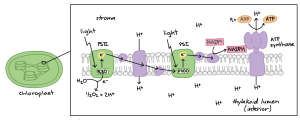W.B.C.S. Examination Notes On – Light Reactions Of Photosynthesis – Botany Notes.
In chloroplasts, the light reactions of photosynthesis involving electron transfer occur in the thylakoid membranes.Continue Reading W.B.C.S. Examination Notes On – Light Reactions Of Photosynthesis – Botany Notes.
Separate biochemical reactions involving the assimilation of carbon dioxide to make glucose are referred to as the Calvin cycle, also sometimes referred to as the “dark reactions”. This will be discussed elsewhere in the section on metabolism .
The chloroplasts are where the energy of light is captured, electrons are stripped from water, oxygen is liberated, electron transport occurs, NADPH is formed, and ATP is generated. The thylakoid membrane corresponds to the inner membrane of the mitochondrion for transport of electrons and proton pumping (Figure <span id=”MathJax-Element-10-Frame” class=”MathJax” style=”font-style: normal;font-weight: normal;line-height: normal;font-size: 17.6px;text-indent: 0px;text-align: left;text-transform: none;letter-spacing: normal;float: none;direction: ltr;max-width: none;max-height: none;min-width: 0px;min-height: 0px;border: 0px;padding: 0px;margin: 0px” role=”presentation” data-mathml=”5.3.4″>5.3.45.3.4).
The thylakoid membrane does its magic using four major protein complexes. These include Photosystem II (PS II), Cytochrome b6f complex (Cb6f), Photosystem I (PS I), and ATP synthase. The roles of these complexes, respectively, are to capture light energy, create a proton gradient from electron movement, capture light energy (again), and use proton gradient energy from the overall process to synthesize ATP.
Light harvesting
Harvesting the energy of light begins in PS II with the absorption of a photon of light at a reaction center. PS II performs this duty best with light at a wavelength of 680 nm and it readily loses an electron to excitation when this occurs, leaving PS II with a positive charge. This electron must be replaced. The ultimate replacement source of electrons is water, but water must lose four electrons and PS II can only accept one at a time.
Manganese centers
An intermediate Oxygen Evolving Complex (OEC) contains four manganese centers that provide the immediate replacement electron that PSII requires. After four electrons have been donated by the OEC to PS II, the OEC extracts four electrons from two water molecules, liberating oxygen and dumping four protons into the thylakoid space, thus contributing to the proton gradient. The excited electron from PS II must be passed to another carrier very quickly, lest it decay back to its original state. It does this, giving its electron within picoseconds to pheophytin .
Pheophytin passes the electron on to protein-bound plastoquinones . The first is known as PQA. PQA hands the electron off to a second plastoquinone (PQB), which waits for a second electron and collects two protons to become PQH2, also known as plastoquinol (Figure <span id=”MathJax-Element-13-Frame” class=”MathJax” style=”font-style: normal;font-weight: normal;line-height: normal;font-size: 17.6px;text-indent: 0px;text-align: left;text-transform: none;letter-spacing: normal;float: none;direction: ltr;max-width: none;max-height: none;min-width: 0px;min-height: 0px;border: 0px;padding: 0px;margin: 0px” role=”presentation” data-mathml=”5.3.9″>5.3.95.3.9). PQH2 passes these to the Cytochrome b6f complex (Cb6f) which uses passage of electrons through it to pump protons into the thylakoid space. ATP synthase makes ATP from the proton gradient created in this way. Cb6f drops the electron off at plastocyanin, which holds it until the next excitation process begins with absorption of another photon of light at 700 nm by PS I.
Absorption of light at PS I
With absorption of a photon of light by PS I, a process begins, that is similar to the process in PS II. PS I gains a positive charge as a result of the loss of an excited electron and pulls the electron in plastocyanin away from it. Meanwhile, the excited electron from PS I passes through an iron-sulfur protein, which gives the electron to ferredoxin (another iron sulfur protein). Ferredoxin then passes the electron off to the last protein in the system known as Ferredoxin:NADP+ oxidoreductase, which gives the electron and a proton to NADP+, creating NADPH.
Note that reduction of NADP+ to NADPH requires two electrons and one proton, so the four electrons and two protons from oxidation of water will result in production of two molecules of NADPH. At this point, the light cycle is complete – water has been oxidized, ATP has been created, and NADPH has been made. The electrons have made their way from water to NADPH via carriers in the thylakoid membrane and their movement has released sufficient energy to make ATP. Energy for the entire process came from four photons of light.
The two photosystems performing all of this magic are protein complexes that are similar in structure and means of operation. They absorb photons with high efficiency so that whenever a pigment in the photosynthetic reaction center absorbs a photon, an electron from the pigment is excited and transferred to another molecule almost instantaneously. This reaction is called photo-induced charge separation and it is a unique means of transforming light energy into chemical forms.
Please subscribe here to get all future updates on this post/page/category/website


 +919674493673
+919674493673  mailus@wbcsmadeeasy.in
mailus@wbcsmadeeasy.in







































































































